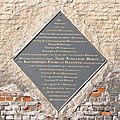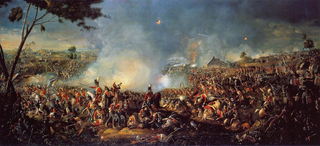
The Battle of Waterloo was fought on Sunday 18 June 1815, near Waterloo, marking the end of the Napoleonic Wars. A French army under the command of Napoleon was defeated by two armies of the Seventh Coalition. One of these was a British-led force with units from the United Kingdom, the Netherlands, Hanover, Brunswick, and Nassau, under the command of the Duke of Wellington. The other comprised three corps of the Prussian army under Field Marshal Blücher; a fourth corps of this army fought at the Battle of Wavre on the same day. The battle was known contemporarily as the Battle of Mont Saint-Jean in France and La Belle Alliance in Prussia.

Waterloo is a 1970 English-language epic historical war film about the Battle of Waterloo. A co-production between Italy and the Soviet Union, it was directed by Sergei Bondarchuk and produced by Dino De Laurentiis. It stars Rod Steiger as Napoleon Bonaparte and Christopher Plummer as the Duke of Wellington with a cameo by Orson Welles as Louis XVIII of France. Other stars include Jack Hawkins as General Sir Thomas Picton, Virginia McKenna as the Duchess of Richmond and Dan O'Herlihy as Marshal Ney.

The Battle of Ligny, in which French troops of the Armée du Nord under the command of Napoleon I defeated part of a Prussian army under Field Marshal Blücher, was fought on 16 June 1815 near Ligny in what is now Belgium. The result was a tactical victory for the French, but the bulk of the Prussian army survived the battle in good order, was reinforced by Prussian troops who had not fought at Ligny, and played a role two days later at the Battle of Waterloo. The Battle of Ligny was the last victory in Napoleon's military career.

The Hundred Days, also known as the War of the Seventh Coalition, marked the period between Napoleon's return from eleven months of exile on the island of Elba to Paris on 20 March 1815 and the second restoration of King Louis XVIII on 8 July 1815. This period saw the War of the Seventh Coalition, and includes the Waterloo Campaign and the Neapolitan War as well as several other minor campaigns. The phrase les Cent Jours was first used by the prefect of Paris, Gaspard, comte de Chabrol, in his speech welcoming the king back to Paris on 8 July.
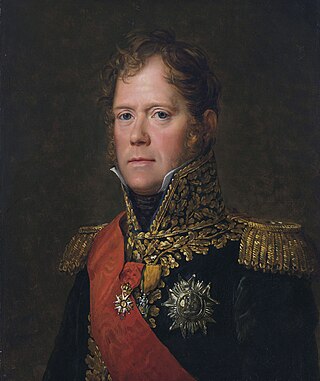
Michel Ney, 1st Prince de la Moskowa, 1st Duke of Elchingen was a French military commander and Marshal of the Empire who fought in the French Revolutionary Wars and the Napoleonic Wars.

The King's German Legion was a British Army unit of mostly expatriated German personnel during the period 1803–16. The legion achieved the distinction of being the only German force to fight without interruption against the French during the Napoleonic Wars.
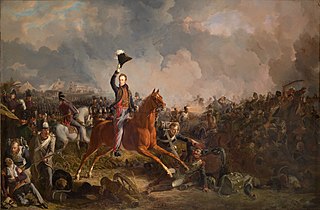
The Battle of Quatre Bras was fought on 16 June 1815, as a preliminary engagement to the decisive Battle of Waterloo that occurred two days later. The battle took place near the strategic crossroads of Quatre Bras and was contested between elements of the Duke of Wellington's Anglo-allied army and the left wing of Napoleon Bonaparte's French Armée du Nord under Marshal Michel Ney. The battle was a tactical victory for Wellington, but because Ney prevented him going to the aid of Blucher's Prussians who were fighting a larger French army under the command of Napoleon Bonaparte at Ligny it was a strategic victory for the French.

The Waterloo campaign was fought between the French Army of the North and two Seventh Coalition armies, an Anglo-allied army and a Prussian army. Initially the French army had been commanded by Napoleon Bonaparte, but he left for Paris after the French defeat at the Battle of Waterloo. Command then rested on Marshals Soult and Grouchy, who were in turn replaced by Marshal Davout, who took command at the request of the French Provisional Government. The Anglo-allied army was commanded by the Duke of Wellington and the Prussian army by Field Marshall Graf von Blücher.

Sharpe's Waterloo is a historical novel in the Richard Sharpe series by Bernard Cornwell. Originally published in 1990 under the title Waterloo, it is the eleventh novel of the Sharpe series and the twentieth novel in chronological order. Cornwell stated that he intended to end the series here, but later changed his mind.

The Lion's Mound is a large conical artificial hill in the municipality of Braine-l'Alleud, Walloon Brabant, Belgium. King William I of the Netherlands ordered its construction in 1820, and it was completed in 1826. It commemorates the spot on the battlefield of Waterloo where the king's elder son, Prince William of Orange, is presumed to have been wounded on 18 June 1815, as well as the Battle of Quatre Bras, which had been fought two days earlier.
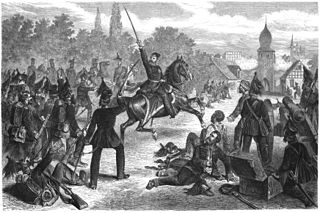
The Brunswick Ducal Field-Corps, commonly known as the Black Brunswickers in English and the Schwarze Schar or Schwarze Legion in German, were a military unit in the Napoleonic Wars. The corps was raised from volunteers by German-born Frederick William, Duke of Brunswick-Wolfenbüttel (1771–1815). The Duke was a harsh opponent of Napoleon Bonaparte's occupation of his native Germany. Formed in 1809 when war broke out between the First French Empire and the Austrian Empire, the corps initially comprised a mixed force, around 2,300 strong, of infantry, cavalry and later supporting artillery.
Sharpe's Waterloo is a British television drama, the 14th part of a series that follows the career of Richard Sharpe, a fictional British soldier during the Napoleonic Wars. The adaptation is based on the 1990 novel of the same name by Bernard Cornwell.

Konrad Ludwig Georg Baring was an officer in the army of the Electorate of Hanover and the British army's King's German Legion. Some sources also give his name as Baron Georg(e) von Baring.

François Étienne de Kellermann, 2nd Duke of Valmy was a French cavalry general noted for his daring and skillful exploits during the Napoleonic Wars. He was the son of François Christophe de Kellermann and the father of the diplomat François Christophe Edmond de Kellermann.
Van Bylandt's brigade is the nickname, used in military historiography for the 1st brigade of the 2nd Netherlands division of the Mobile Army of the United Kingdom of the Netherlands, a Dutch and Belgian infantry brigade led by Major General Willem Frederik Graaf van Bylandt which fought in the Waterloo Campaign (1815).

After the fighting at Quatre Bras the two opposing commanders Marshal Ney and the Duke of Wellington initially held their ground while they obtained information about what had happened at the larger Battle of Ligny. They received intelligence that the Prussian army under the command of Prince Blücher had been defeated by the French Army of the North under the command of Napoleon Bonaparte.

Papelotte Farm is located at Rue Du Dimont a rural road in the Municipality of Braine-l'Alleud around 15 km (9.3 mi) south of Brussels, Belgium. On June 18, 1815, during the pivotal Battle of Waterloo it served as one of the advanced defensible positions of the Anglo-allied army under the command of the Duke of Wellington. Along with the walled farm compounds of Hougoumont and La Haye Sainte, it proved to be instrumental to the delay and the disruption of the opposing Napoleonic army's progress on the battlefield. Napoleon diverted disproportionately large numbers of troops in order to capture or eliminate these perimeters, while he failed to achieve a decisive break through in one of several attacks on the lines of the Allies.

Waterloo: The History of Four Days, Three Armies and Three Battles is a history book written by Bernard Cornwell, first published in Great Britain by William Collins on 11 September 2014, and by Harper Collins Publishers on 5 May 2015 in the United States. It is Cornwell's first work of nonfiction, after publishing more than forty novels in the historical fiction genre, including the popular Richard Sharpe series taking place during the Napoleonic Wars. The book recounts the Battle of Waterloo on 18 June 1815, including preceding events from the campaign of the same name and The Hundred Days.





